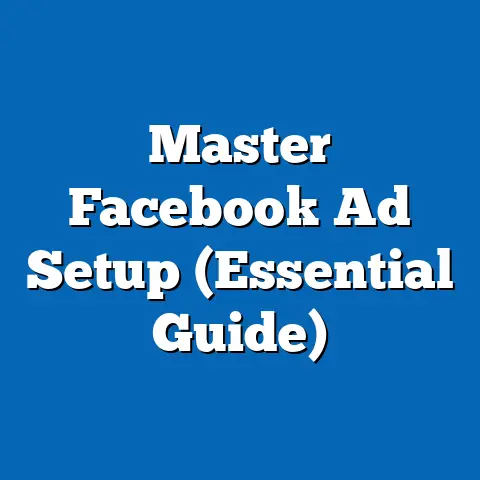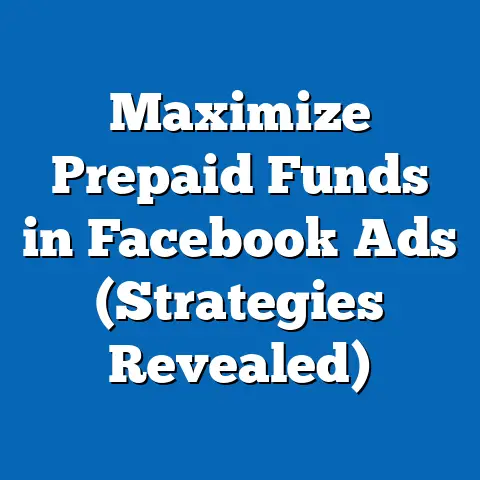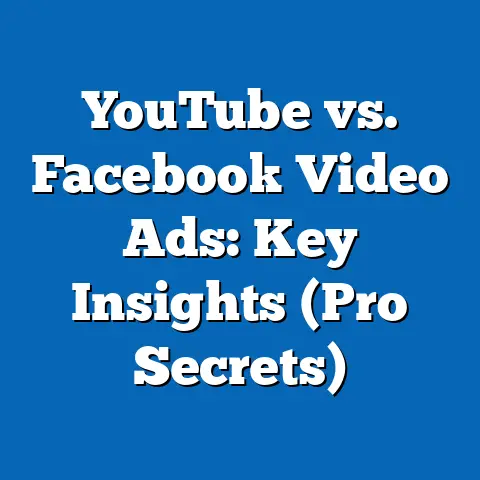Unlocking Facebook Ad Preferences (Expert Guide Inside)
Facebook advertising is a powerhouse. It’s a tool that, when wielded correctly, can transform your business, skyrocket your brand awareness, and deliver a return on investment that leaves you smiling. But let’s be honest, navigating the world of Facebook Ads can feel like wandering through a maze. The key to escaping that maze and finding the treasure at its center lies in understanding and mastering Facebook ad preferences.
Think of Facebook ad preferences as the GPS for your marketing campaigns. They guide you, helping you pinpoint exactly who you want to reach, ensuring your message lands in the hands of those most likely to convert. Without this understanding, you’re essentially throwing money into the void, hoping something sticks. And in today’s fiercely competitive digital landscape, hope isn’t a strategy.
Section 1: Understanding Facebook Ad Preferences
So, what exactly are Facebook ad preferences? Simply put, they’re a collection of data points that Facebook gathers about its users. This data is then used to tailor the ads that users see, making them more relevant and engaging. It’s a win-win situation: users see ads that are more likely to interest them, and advertisers get their message in front of the right audience.
Why are they so significant? Because relevance is king (or queen!) in the world of advertising. The more relevant your ad is to a user, the more likely they are to pay attention, click, and ultimately convert. Facebook ad preferences are the key to achieving that relevance. They allow you to move beyond broad, generic targeting and zero in on the specific individuals who are most likely to be interested in your product or service.
How does Facebook collect this data? It’s a multi-faceted process. Facebook gathers information through various means, including:
- User-provided information: This includes everything users voluntarily share on their profiles, such as their age, gender, location, education, job title, interests, and relationship status.
- Browsing behavior: Facebook tracks the websites and apps users visit, the content they interact with (likes, shares, comments), and the searches they perform.
- Offline activity: Through partnerships with businesses, Facebook can even track offline purchases and activities, providing a more complete picture of user behavior.
- Mobile device data: Facebook can access data from users’ mobile devices, such as location information, app usage, and device type.
This constant stream of data allows Facebook to build incredibly detailed profiles of its users, making it possible for advertisers to target their ads with unprecedented precision.
The categories of ad preferences are diverse, but some of the most important include:
- Interests: This is based on the pages users like, the groups they join, and the content they interact with.
- Demographics: This includes age, gender, location, education, job title, and relationship status.
- Behaviors: This is based on users’ online and offline activities, such as purchase history, travel habits, and device usage.
- Location Targeting: This allows you to target users based on their current location, recent travels, or home location.
Takeaway: Facebook ad preferences are the bedrock of successful Facebook advertising. Understanding how they work and the types of data they encompass is the first step to creating highly effective campaigns.
Section 2: Navigating Facebook’s Ad Preferences Dashboard
Now that we understand what Facebook ad preferences are, let’s dive into how you can actually access and navigate the dashboard. Whether you’re a user curious about the data Facebook has on you or an advertiser looking to understand your target audience better, the Ad Preferences dashboard is your window into this world.
Here’s a step-by-step guide on accessing your ad preferences:
- Log in to Facebook: Start by logging into your Facebook account.
- Access Settings & Privacy: Click on the downward-facing arrow in the top right corner of the screen and select “Settings & Privacy.”
- Go to Settings: From the “Settings & Privacy” dropdown, click on “Settings.”
- Navigate to Ads: In the left-hand menu, click on “Ads.” This will take you to the Ad Preferences dashboard.
Once you’re in the dashboard, you’ll see several key sections:
- Advertisers You’ve Interacted With: This section shows you a list of advertisers whose ads you’ve clicked on, liked, or otherwise interacted with. This can give you insights into the types of businesses that are targeting you.
- Ad Topics: This section displays the topics and interests that Facebook believes you’re interested in, based on your activity on and off the platform. These are the categories that advertisers can use to target you.
- Ad Settings: This section allows you to control certain aspects of your ad experience, such as whether you see ads based on your activity on websites and apps off of Facebook.
- About You: This section displays the demographic information that Facebook uses to target ads to you, such as your age, gender, and location.
Analyzing and interpreting the information in the dashboard is crucial. As a user, reviewing your ad preferences can help you understand how Facebook sees you and how your data is being used. You can remove interests that are no longer relevant or adjust your settings to limit the amount of data Facebook collects about you.
As an advertiser, the Ad Preferences dashboard provides valuable insights into the interests and demographics of your target audience. By seeing the types of topics and interests that Facebook associates with its users, you can gain a better understanding of how to target your ads effectively.
Why should you regularly review ad preferences?
- For Users: Your interests and preferences change over time. Regularly reviewing your ad preferences allows you to ensure that the ads you see are relevant and interesting. It also gives you control over your privacy and data.
- For Advertisers: Consumer behavior is constantly evolving. Regularly reviewing the Ad Preferences dashboard can help you stay on top of trends and ensure that your targeting strategies are up-to-date. It can also help you identify new targeting opportunities and refine your existing campaigns.
Takeaway: The Facebook Ad Preferences dashboard is a powerful tool for both users and advertisers. By understanding how to navigate the dashboard and interpret the information it provides, you can gain valuable insights into your target audience and take control of your ad experience.
Section 3: Customizing Ad Targeting for Maximum Impact
Now for the real magic: putting your knowledge of Facebook ad preferences to work! This is where you transform data into dollars, turning insights into impactful ad campaigns.
How can marketers utilize ad preferences to customize their targeting strategies? The key is to be specific and relevant. Don’t just target “people interested in fitness.” Instead, target “people interested in CrossFit and who have purchased workout equipment online in the past 6 months.” The more specific you are, the more likely you are to reach the right audience.
Here are a few strategies for customizing your ad targeting based on ad preferences:
- Layering Interests: Combine multiple interests to narrow your audience. For example, if you’re selling organic baby food, you could target parents interested in organic food, baby products, and healthy living.
- Demographic Targeting: Use demographic data to target specific age groups, genders, or locations. This is particularly useful for products or services that are relevant to specific demographics.
- Behavioral Targeting: Target users based on their online and offline behaviors. For example, you could target people who have recently purchased a similar product or who have visited your website.
- Custom Audiences: Upload your own customer data (email addresses, phone numbers) to create a custom audience. Facebook will then match this data with its user profiles, allowing you to target your existing customers with personalized ads.
The Power of Lookalike Audiences:
One of the most powerful features of Facebook advertising is the ability to create Lookalike Audiences. A Lookalike Audience is a group of people who share similar characteristics to your existing customers or website visitors.
How do you create a Lookalike Audience?
- Start with a Source Audience: This could be a custom audience of your existing customers, your website visitors, or even people who have engaged with your Facebook page.
- Choose a Similarity Level: Facebook allows you to choose how similar you want your Lookalike Audience to be to your source audience. A smaller percentage (e.g., 1%) will result in a more similar audience, while a larger percentage (e.g., 10%) will result in a larger, but less similar, audience.
- Let Facebook Do Its Thing: Facebook will then analyze the characteristics of your source audience and identify other users who share those characteristics.
Examples of Tailoring Ads Based on Preferences:
- A local bakery: Could target people who live within a 5-mile radius of their store and who are interested in baking, desserts, and local businesses.
- An online clothing store: Could target women aged 25-35 who are interested in fashion, online shopping, and specific clothing brands.
- A software company: Could target business owners and marketing professionals who are interested in digital marketing, CRM software, and business technology.
My Personal Experience: I once worked with a small e-commerce business selling handcrafted jewelry. Initially, their Facebook Ads were performing poorly. We were targeting a broad audience of “people interested in jewelry.” After digging into the data and understanding their customer base better, we refined our targeting. We started targeting women aged 30-50 who were interested in handcrafted jewelry, fair trade products, and supporting small businesses. We also created a Lookalike Audience based on their existing customer list. The results were dramatic. Our click-through rate increased by 300%, and our conversion rate doubled. This experience solidified my belief in the power of customized ad targeting.
Takeaway: Don’t settle for generic targeting. Use Facebook ad preferences to create highly specific, relevant audiences. Experiment with different targeting options and continuously refine your strategies based on performance data. Remember, the more relevant your ad is to the user, the more likely they are to convert.
Section 4: The Role of Analytics in Refining Ad Preferences
Customizing your ad targeting is just the first step. The real magic happens when you combine that customization with the power of analytics. Data tracking and analysis are essential for optimizing your Facebook ad campaigns and ensuring that you’re getting the best possible return on investment.
Why are analytics so important?
- Measure Performance: Analytics allow you to track the performance of your ads, including metrics like impressions, clicks, conversions, and cost per conversion.
- Identify Trends: By analyzing your data, you can identify trends and patterns in user behavior. This can help you understand what’s working and what’s not.
- Refine Targeting: Analytics provide insights into the demographics, interests, and behaviors of the people who are responding to your ads. This allows you to refine your targeting and reach a more relevant audience.
- Optimize Budget: By tracking your costs and conversions, you can optimize your budget and allocate your resources to the most effective campaigns.
Using Facebook Ads Manager for Analysis:
Facebook Ads Manager is your central hub for managing and analyzing your ad campaigns. It provides a wealth of data and reporting tools that can help you understand the performance of your ads.
Here are some key metrics to track in Facebook Ads Manager:
- Impressions: The number of times your ad was displayed.
- Reach: The number of unique people who saw your ad.
- Clicks: The number of times people clicked on your ad.
- Click-Through Rate (CTR): The percentage of people who saw your ad and clicked on it. (Clicks / Impressions) * 100
- Conversions: The number of people who took a desired action after clicking on your ad (e.g., making a purchase, filling out a form, downloading a file).
- Cost Per Conversion (CPC): The average cost of each conversion. (Total Ad Spend / Conversions)
- Return on Ad Spend (ROAS): The amount of revenue generated for every dollar spent on advertising. (Revenue from Ads / Total Ad Spend)
A/B Testing: Your Secret Weapon
A/B testing, also known as split testing, is a powerful technique for optimizing your ad campaigns. It involves creating two or more versions of an ad and testing them against each other to see which one performs best.
How does A/B testing work?
- Identify a Variable to Test: This could be the ad copy, the image, the call-to-action, or the targeting options.
- Create Two or More Versions of the Ad: Change only the variable you’re testing. Keep everything else the same.
- Run the Ads Simultaneously: Facebook will split your audience and show each version of the ad to a different group of people.
- Track the Results: Monitor the performance of each version of the ad and identify the winner.
- Implement the Winner: Use the winning version of the ad in your ongoing campaigns.
Example: Let’s say you’re running an ad for a new product. You could A/B test two different images to see which one resonates better with your audience. Or you could A/B test two different headlines to see which one generates more clicks.
My Experience with A/B Testing: I remember working with a client who was launching a new online course. We had two versions of their ad: one that focused on the benefits of the course and another that focused on the features. After running the ads for a week, we discovered that the version that focused on the benefits was performing significantly better. We then switched our entire campaign to focus on the benefits, which resulted in a 40% increase in enrollment.
Takeaway: Analytics and A/B testing are essential for optimizing your Facebook ad campaigns. By tracking your performance, identifying trends, and continuously testing different ad elements, you can refine your targeting, improve your ROI, and achieve your marketing goals.
Section 5: Legal and Ethical Considerations
While Facebook ad preferences offer incredible power, it’s crucial to wield that power responsibly. The use of user data for ad targeting comes with significant legal and ethical considerations that you need to be aware of.
GDPR and CCPA Compliance:
- GDPR (General Data Protection Regulation): This is a European Union law that protects the privacy and personal data of EU citizens. If you’re targeting users in the EU, you need to comply with GDPR. This means obtaining explicit consent from users before collecting and using their data.
- CCPA (California Consumer Privacy Act): This is a California law that gives California residents more control over their personal data. If you’re targeting users in California, you need to comply with CCPA. This means providing users with the right to know what data you’re collecting about them, the right to delete their data, and the right to opt out of the sale of their data.
Ethical Responsibilities:
Beyond legal compliance, you also have an ethical responsibility to use Facebook ad preferences in a way that respects user privacy and builds trust.
Here are some best practices for ethical Facebook advertising:
- Transparency: Be transparent with users about how you’re collecting and using their data.
- Respect Privacy: Only collect data that is necessary for your advertising purposes.
- Avoid Discrimination: Don’t use ad preferences to discriminate against certain groups of people.
- Be Truthful: Make sure your ads are truthful and don’t make misleading claims.
- Obtain Consent: Always obtain explicit consent from users before collecting and using their data, especially if you’re targeting users in the EU.
- Provide Opt-Out Options: Give users the option to opt out of targeted advertising.
- Protect Data Security: Take steps to protect user data from unauthorized access and misuse.
Maintaining Transparency with Customers:
Transparency is key to building trust with your customers. Make sure your privacy policy is clear and easy to understand. Explain how you collect and use user data, and give users control over their data.
Example: I always recommend that clients include a link to their privacy policy in their Facebook ads. This shows users that you’re committed to protecting their privacy and builds trust.
My Personal Stance: I believe that ethical advertising is not just the right thing to do, it’s also good for business. By being transparent and respectful of user privacy, you can build long-term relationships with your customers and create a brand that people trust.
Takeaway: Legal and ethical considerations are paramount when using Facebook ad preferences. Comply with all applicable laws and regulations, and always prioritize user privacy and transparency.
Conclusion
Unlocking the power of Facebook ad preferences is essential for achieving success in today’s competitive digital landscape. By understanding how these preferences work, how to navigate the Facebook Ad Preferences dashboard, and how to ethically and effectively use this knowledge to create laser-focused, high-converting ad campaigns, you can transform your Facebook advertising game.
We’ve covered a lot in this guide, from the basics of Facebook ad preferences to advanced strategies for customizing your targeting and optimizing your campaigns. Remember, the key takeaways are:
- Facebook ad preferences are a collection of data points that Facebook gathers about its users.
- These preferences are used to tailor the ads that users see, making them more relevant and engaging.
- You can access and navigate the Facebook Ad Preferences dashboard to understand how Facebook sees you and how your data is being used.
- You can customize your ad targeting based on ad preferences to reach a more specific and relevant audience.
- Analytics and A/B testing are essential for optimizing your Facebook ad campaigns.
- Legal and ethical considerations are paramount when using Facebook ad preferences.
Now it’s time to take action! Review your own ad preferences on Facebook to understand how your data is being used. Implement the strategies outlined in this guide to customize your ad targeting and optimize your campaigns. Continuously track your performance, refine your strategies, and stay up-to-date on the latest trends and best practices.
By mastering Facebook ad preferences, you can gain a significant competitive advantage and achieve your marketing goals. Don’t wait any longer. Start optimizing your ad campaigns today and unlock the full potential of Facebook advertising!





